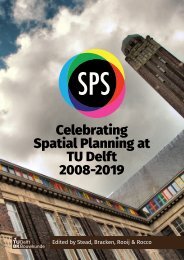*Celebrating Spatial Planning at TU Delft: 2008-2019. Edited by Stead, Bracken, Rooij & Rocco
This is a summary of the achievements of the session Spatial Planning & Strategy of the Department of Urbanism, Faculty of Architecture and the Built Environment, TU Delft, led by Professor Vincent Nadin between 2008 and 2019.
This is a summary of the achievements of the session Spatial Planning & Strategy of the Department of Urbanism, Faculty of Architecture and the Built Environment, TU Delft, led by Professor Vincent Nadin between 2008 and 2019.
Create successful ePaper yourself
Turn your PDF publications into a flip-book with our unique Google optimized e-Paper software.
Urbanism . <strong>TU</strong> <strong>Delft</strong> 101<br />
The Power of Regional Design<br />
FRANCISCO COLOMBO & JEROEN VAN SCHAICK, REGIONAL DESIGNERS AT PROVINCE SOUTH HOLLAND.<br />
At <strong>TU</strong> <strong>Delft</strong> we have a strong<br />
tradition in teaching and<br />
researching regional design.<br />
This tradition was built up over<br />
more than three decades working<br />
in close cooper<strong>at</strong>ion with practice.<br />
As practitioners, researchers, and<br />
teachers we have experienced<br />
the power of regional design as<br />
a policy instrument serving the<br />
practice of regional planning. As<br />
such, regional design is fundamentally<br />
different from classical urban<br />
design.<br />
Regional visioning through regional<br />
design serves as a compass in a<br />
complex planning context, providing<br />
direction for a multitude of<br />
stakeholders, and ensuring th<strong>at</strong><br />
decisions are well-substanti<strong>at</strong>ed.<br />
Regional design provides visual<br />
answers to questions of how “the<br />
region” is experienced as context,<br />
space, institution, or physical precondition<br />
for sustainable development.<br />
Administr<strong>at</strong>ors, interested<br />
parties, citizens’ collectives, and<br />
market players can align themselves<br />
with, and g<strong>at</strong>her around,<br />
such imagery. Local developments<br />
and decisions can gain strength <strong>by</strong><br />
positioning themselves within “bigger”<br />
regional narr<strong>at</strong>ives.<br />
Regional designers now face the<br />
daunting task of interpreting the<br />
new assignments of economic<br />
modernis<strong>at</strong>ion, energy transition,<br />
the impact of new technology, and<br />
clim<strong>at</strong>e adapt<strong>at</strong>ion in terms of concepts<br />
and narr<strong>at</strong>ives. The power of<br />
regional design will lie in the identific<strong>at</strong>ion<br />
and visualis<strong>at</strong>ion of these<br />
new sp<strong>at</strong>ial challenges. To make a<br />
difference, the university needs to<br />
develop substanti<strong>at</strong>ed theoretical<br />
and methodological frameworks<br />
for regional design, and to prepare<br />
professionals and academics for<br />
work in multidisciplinary teams<br />
and complex governance settings.<br />
Fig. 64: Stedenbaan (TOD) in South Holland, Province South Holland. Map provided <strong>by</strong> F. Colombo.




